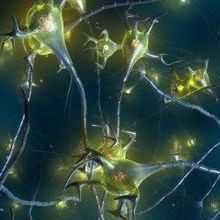Login
Subscribeelectrophysiology

Elusive Tsetse Pheromones
Danielle Gerhard, PhD | Jul 5, 2023 | 2 min read
Researchers discovered novel attractants that may improve Tsetse fly traps and help control disease spread.

How Neurons in a Dish Learned to Play “Pong”
Dan Robitzski | Oct 12, 2022 | 5 min read
The DishBrain system can send and receive electrophysiological signals to and from living neurons, training the cells to accomplish a task.

Infographic: Reverse Signaling Between Neurons
Christie Wilcox, PhD | Jun 4, 2021 | 1 min read
So-called mossy fiber synapses in the hippocampus can meter the amount of neurotransmitter they receive by sending glutamate against the usual direction of synaptic flow.

Hippocampal Cell Communication Is Bidirectional: Study
Christie Wilcox, PhD | Jun 4, 2021 | 6 min read
In an unexpected twist in neuroscience dogma, the cells on the receiving end of neurotransmission appear to be able to release glutamate to regulate the transmitting cell’s activity.

Study Points to Novel Role for Microglia in Down Syndrome
Catherine Offord | Oct 6, 2020 | 4 min read
Overactive immune cells identified in a mouse model and in postmortem human brain tissue may offer a potential therapeutic target for cognitive delays associated with the condition, researchers report.

Thirst and Drinking Spark Widespread Activity in the Mouse Brain
Ruth Williams | Apr 4, 2019 | 3 min read
Researchers have recorded tens of thousands of brain cells in mice as the animals transitioned from feeling thirsty to quenched.

Image of the Day: This Little Piggy
Sukanya Charuchandra | Sep 20, 2018 | 1 min read
Recordings of electrical activity in porcine brains finds similarities to rodent neural tissue.

Long-Sought Hearing Channel Protein Found
Abby Olena, PhD | Aug 22, 2018 | 3 min read
After a decades-long pursuit, researchers have confirmed the identity of the pore of the mechanotransduction channel in vertebrates’ inner ear hair cells.

Computer Programs Sift Through Spikes in Nerve Cells’ Activity
Ashley Yeager | May 1, 2018 | 7 min read
Software that can separate signals from noise brings neuroscientists a step closer to understanding neurons’ patterns of communication.

Implanted Magnetic Probes Measure Brain Activity
Ruth Williams | Nov 1, 2017 | 3 min read
Micrometer-size magnetrodes detect activity-generated magnetic fields within living brains.

Infographic: Reading the Mind’s Magnetism
Ruth Williams | Oct 31, 2017 | 1 min read
Newly designed sensors detect the magnetic fields generated by electrical activity within cat brains.

Image of the Day: Make or Break a Habit
The Scientist | Sep 7, 2017 | 1 min read
Deep within the forebrains of mice, scientists have identified an elusive cell type responsible for forming habits.

Robotic Patch Clamping Gains Eyes
Diana Kwon | Aug 30, 2017 | 4 min read
Two groups of scientists combined automation with two-photon microscopy to target and record specific neurons in living animals.

New and Old Techniques in Modern Neuroscience
Alison F. Takemura | Oct 1, 2016 | 6 min read
Imaging and manipulating the brain has come a long way from electrodes and the patch clamp, though such traditional tools remain essential.

New Gecko-Inspired Adhesive
Jef Akst | Apr 6, 2016 | 2 min read
Flexible patches of silicone that stick to skin and conduct electricity could serve as the basis for a new, reusable electrode for medical applications.

Top Technical Advances 2015
Kerry Grens | Dec 23, 2015 | 5 min read
The Scientist’s choice of major improvements in imaging, optogenetics, single-cell analyses, and CRISPR

Wired Flower
Karen Zusi | Nov 24, 2015 | 2 min read
Researchers use a conducting polymer to construct circuits inside plant cuttings in a proof-of-concept study.

Identity-Shifting Brain Cells
Ruth Williams | Sep 10, 2015 | 3 min read
Cortical interneurons in mice exhibit activity-dependent alterations to their characteristic firing patterns.

Cutting the Wire
Jeffrey M. Perkel | Dec 1, 2014 | 8 min read
Optical techniques for monitoring action potentials
